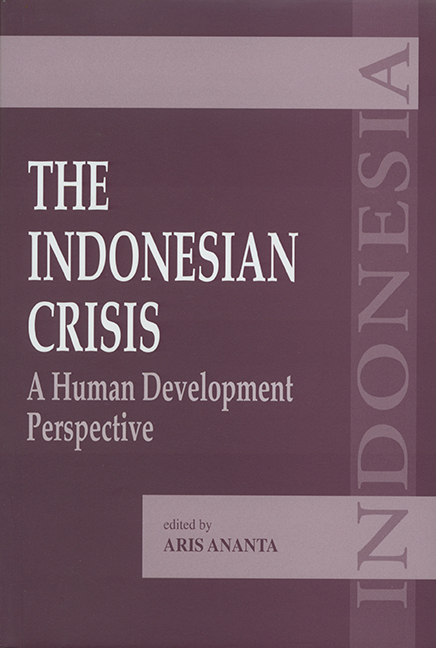Book contents
- Frontmatter
- Contents
- Acknowledgements
- List of Contributors
- Part I Introduction
- 1 What Do We Learn from the Crisis? Insights on Human Development in Indonesia during 1997–99
- 2 Macroeconomic Recovery: Facts and Prospects
- 3 Indonesia's Economic Transformation: Before and During the Economic Crisis
- 4 Modelling the Repercussions of Financial Shock on Socio-economic Indicators
- Part II Human Capital
- Part III Purchasing Power
- Part IV Emerging Issues
- Index
3 - Indonesia's Economic Transformation: Before and During the Economic Crisis
from Part I - Introduction
Published online by Cambridge University Press: 21 October 2015
- Frontmatter
- Contents
- Acknowledgements
- List of Contributors
- Part I Introduction
- 1 What Do We Learn from the Crisis? Insights on Human Development in Indonesia during 1997–99
- 2 Macroeconomic Recovery: Facts and Prospects
- 3 Indonesia's Economic Transformation: Before and During the Economic Crisis
- 4 Modelling the Repercussions of Financial Shock on Socio-economic Indicators
- Part II Human Capital
- Part III Purchasing Power
- Part IV Emerging Issues
- Index
Summary
Introduction
It is a fact that Indonesia's economic performance in the first thirty years of the New Order government had been fairly impressive. In 1969, Indonesia's per capita income was only about US$70. By 1996, the per capita income had increased more than tenfold to US$1080. The continued economic growth in the thirty years of the New Order period had transformed the structure of the economy. Using Chenery and Syrquin's (1975) terms, structural change takes place as per capita income rises.
Booth (1998) has stated that the years from the mid-1960s to the early 1980s were notable ones in Indonesian economic history. The average annual rate of growth of GDP accelerated to more than 7 per cent per annum. This period also coincided with a significant improvement in the country's terms of trade.
However, Indonesia was confronted with a series of problems in the 1980s. The decline in oil prices after 1982 sharply reduced export earnings and budget revenues. At the peak of the oil-boom years, 80 per cent of export earnings and 70 per cent of budget revenue came from oil. As a result, the large decline in oil prices severed Indonesia's balance of payments. The government undertook some adjustment programmes to increase economic efficiency and altered its trade regime to be more outward-looking, making the development of non-oil and gas exports a top priority. During 1983 to 1995, the government introduced no less than twenty-four packages of economic reforms aimed at increasing economic efficiency and encouraging investment as well as non-oil exports. Along with this change of orientation, the government also shifted its investment policy from investment control to investment encouragement.
This adjustment programme commenced in 1983 and was intensified following the dramatic drop of oil prices in 1986. In 1983, the government cut public investment, initiated a major re-phasing of large capital-intensive projects, devalued the rupiah, and undertook financial reforms to remove interest-rate controls and credit ceilings. In 1984-86, tax reforms were introduced to mobilize domestic resources. Finally, various trade reforms were launched to improve the trade and industrial policy regime.
In 1997, however, Indonesia faced the most serious problem in its economic history.
- Type
- Chapter
- Information
- The Indonesian CrisisA Human Development Perspective, pp. 53 - 75Publisher: ISEAS–Yusof Ishak InstitutePrint publication year: 2002



